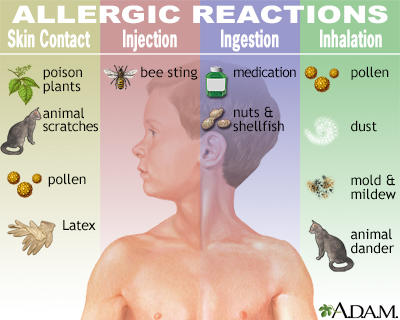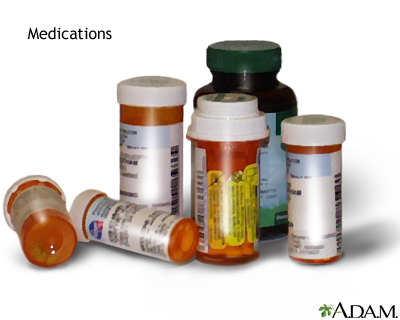Pregnancy SmartSiteTM
Anaphylactic reaction; Anaphylactic shock; Shock - anaphylactic; Allergic reaction - anaphylaxis DefinitionAnaphylaxis is a life-threatening type of allergic reaction. CausesAnaphylaxis is a severe, whole-body allergic reaction to a chemical that has become an allergen. An allergen is a substance that, for most people, is harmless, but in some people, it can cause an allergic reaction. After being exposed to a substance such as bee sting venom, the person's immune system becomes sensitized to it. When the person is exposed to that allergen again, an allergic reaction may occur. Anaphylaxis usually happens quickly after the exposure. The condition is severe and involves the whole body. Tissues in different parts of the body release histamine and other substances. This causes the airways to tighten and leads to other symptoms. Some medicines (morphine, x-ray dye, aspirin, and others) may cause an anaphylactic-like reaction (often called an anaphylactoid reaction) when people are first exposed to them. These reactions are not the same as the immune system response that occurs with true anaphylaxis. But, the symptoms, risk of complications, and treatment are the same for both types of reactions. Anaphylaxis can occur in response to any allergen. Common causes include: Pollen and other inhaled allergens rarely cause anaphylaxis. Some people have an anaphylactic reaction with no known cause. Anaphylaxis is life threatening and can occur at any time. Risks include a history of any type of allergic reaction. SymptomsSymptoms develop quickly, often within seconds or minutes. They may include any of the following:
Exams and TestsThe health care provider will examine the person and ask about what might have caused the condition. Tests for the allergen that caused anaphylaxis (if the cause is not obvious) may be done after treatment. TreatmentAnaphylaxis is an emergency condition that needs medical attention right away. Call 911 or the local emergency number immediately. Check the person's airway, breathing, and circulation, which are known as the ABC's of Basic Life Support. A warning sign of dangerous throat swelling is a very hoarse or whispered voice, or coarse sounds when the person is breathing in air. If necessary, begin rescue breathing and CPR.
DO NOT:
Paramedics or other providers may place a tube through the nose or mouth into the airways. Or emergency surgery will be done to place a tube directly into the trachea. The person may receive medicines to further reduce symptoms. Outlook (Prognosis)Anaphylaxis can be life threatening without prompt treatment. Symptoms usually do get better with the right therapy, so it is important to act right away. Possible ComplicationsWithout prompt treatment, anaphylaxis may result in:
When to Contact a Medical ProfessionalCall 911 or the local emergency number if you or someone you know develops severe symptoms of anaphylaxis. Or, go to the nearest emergency room. PreventionTo prevent allergic reactions and anaphylaxis:
ReferencesBarksdale AN, Ross W. Allergy, anaphylaxis, and angioedema. In: Walls RM, ed. Rosen's Emergency Medicine: Concepts and Clinical Practice. 10th ed. Philadelphia, PA: Elsevier; 2023:chap 106. Dreskin SC, Stitt JM. Anaphylaxis. In: Burks AW, Holgate ST, O'Hehir RE, et al, eds. Middleton's Allergy: Principles and Practice. 9th ed. Philadelphia, PA: Elsevier; 2020:chap 75. Schwartz LB, Castells M. Anaphylaxis. In: Goldman L, Cooney KA, eds. Goldman-Cecil Medicine. 27th ed. Philadelphia, PA: Elsevier; 2024:chap 233. Shaker MS, Wallace DV, Golden DBK, et al. Anaphylaxis-a 2020 practice parameter update, systematic review, and Grading of Recommendations, Assessment, Development and Evaluation (GRADE) analysis. J Allergy Clin Immunol. 2020;145(4):1082-1123. PMID: 32001253 pubmed.ncbi.nlm.nih.gov/32001253/. | |
| |
Review Date: 3/31/2024 Reviewed By: Deborah Pedersen, MD, MS, Allergy & Asthma Care, PC, Taunton, MA. Review provided by VeriMed Healthcare Network. Also reviewed by David C. Dugdale, MD, Medical Director, Brenda Conaway, Editorial Director, and the A.D.A.M. Editorial team. The information provided herein should not be used during any medical emergency or for the diagnosis or treatment of any medical condition. A licensed medical professional should be consulted for diagnosis and treatment of any and all medical conditions. Links to other sites are provided for information only -- they do not constitute endorsements of those other sites. No warranty of any kind, either expressed or implied, is made as to the accuracy, reliability, timeliness, or correctness of any translations made by a third-party service of the information provided herein into any other language. © 1997- A.D.A.M., a business unit of Ebix, Inc. Any duplication or distribution of the information contained herein is strictly prohibited. | |

 Shock
Shock Allergic reactions
Allergic reactions Anaphylaxis
Anaphylaxis Hives
Hives Food allergies
Food allergies Insect stings and ...
Insect stings and ... Allergic reactions...
Allergic reactions... Antibodies
Antibodies
